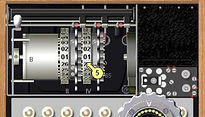6. CREATE ENCRYPTED MESSAGE







Print a copy of the instructions listed below to use as a guide while you set-up your rotor settings.
Note: For the following instructions, I am using my U571 December 1944, Day 16, UKW = B, codesheet. This codesheet can be found by clicking the "MY U571 CODESHEETS" link and choosing the December 1944 codesheet. Other unique codesheets can be created using the Enigma Codebook Tool (Step 3). If you create your own codesheets, you must attach your own unique codesheet .txt file so the message can be decrypted correctly when you email your message to a member.
NOTE: By way of review, items 1-5 listed below have already been completed in Step 5.
1. Open the cover of the Enigma Simulator.
2. Set-up he rotors and rings. Set the rotors and rings using the same U571 December 16, 1944, codesheet as in previous steps.
3. Close cover.
4. Set-up plug settings per U571 December 16, 1944, codesheet.
5. Return to Engima top view.
Important Encoding Tips:
1. You must type each letter. Repeating letters will not produce the same encrypted letter. For example, in the word "food," you must type each letter "O" separately. Each encrypted "O" will have a different letter.
2. If you are writing-down each letter, hold the key down for several seconds so that the illuminated key stays lit while you write the
letter down.
3. There are no numbers on the Enigma keyboard. If you want to use a number, you will have to spell it out in letters.
4. There are also no punctuations marks on the Enigma keyboard. Use the following letters for punctuation:
period = X
comma = ZZ
question mark = FRAGE or FRAQ
To encrypt a message:
OPTION 1 - ORIGINAL METHOD
6. Choose 2 random trigrams. Choose YPX and TMK for our first message.
7. Use the first trigram, YPX, as the start point for the rotors. Dial the number equivalants for YPX into the rotors now. Click inside each rotor window and use the chart that appears to put in the correct number setting that corresponds with each letter:
Y=25, P=16, X=24. You can change the numbers by clicking on the top or bottom of each rotor.
8. Using the Enigma keyboard, type-in the second trigram: TMK. As you type TMK, watch the Enigma lightboard. A letter will illuminate each time you press a key. Write down these three illuminated letters, in order, on a piece of paper. This will produce a third trigram called the "encrypted message key." Write down this third trigram and save it. You will need it in the next section.
9. Change rotors to the second random trigram: TMK. T=20, M=13, K=11.
10. Print your message, letter by letter, on a piece of paper. We will use this sample message.
MYDOGISFRIENDLY.HISNAMEISBUDDHA.HEISSMALLANDBLACK.HEEATSALOTOFPEOPLEFOOD.
11. Type your message, letter by letter, on the Enigma keyboard.
Briefly hold down each key, and write down each letter that
illuminates for each letter that you type. For example:
M = C
Y = H
D = E
O = S
G = Y
etc.
OPTION 2: DIGITAL METHOD USING TEXT BOX AND CLIPBOARD
You can display the plaintext and ciphertext together in a little text box at the bottom of the Enigma by clicking the lock [18] on the wooden box. Click again on the lock to hide the text box. This text box is useful when processing large pieces of text.
The Smart Clipboard
You can call the Smart Clipboard from the Enigma menu or by clicking inside the text box at the bottom of the
Enigma. You can select various ways to format and transfer text to the clipboard. When formatted for ciphertext,
the output is arranged in groups of five letters for the Wehrmacht machine and groups of four letters for both
Naval M3 and M4 machines.
6. Choose 2 random trigrams. Choose YPX and TMK for our first message.
7. Use the first trigram, YPX, as the start point for the rotors. Dial the number equivalants for YPX into the rotors now. Click inside each rotor window and use the chart that appears to put in the correct number setting that corresponds with each letter:
Y=25, P=16, X=24. You can change the numbers by clicking on the top or bottom of each rotor.
8. Using the keyboard, type-in the second trigram: TMK. This will produce a third trigram called the "encrypted message key." Write down this third trigram and save it. You will need it in the next section.
9. Change the rotors to the second random trigram TMK. T=20, M=13, K=11.
10. To open the clipboard, click on (18). The second and third trigrams will appear in the text box. This is normal. Disregard these for now.
11. Click on each letter of the message. The text box will display the encrypted message on the bottom line and your message on the top line.
12. When you are finished typing your message, move the mouse over the text box. Click on the textbox when the "Click here to Copy Output to Clipboard" message appears.
13. Click on "To Clipboard."
14. In Step 7, SENDING YOUR MESSAGE, you will paste this copied message into the message section of the email.
